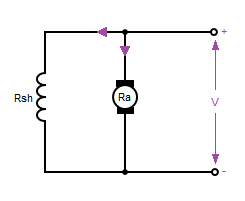Why DC Shunt Motor is a Constant Speed Motor?
The speed of a DC motor is directly proportional to the voltage across the armature terminals and inversely proportional to the flux (φ) due to the field windings (N ∝ 1 / φ), that is N ∝ 1 / Ish.

In a shunt motor, the shunt field current Ish is always a constant since the field winding is connected in parallel to the armature winding and the supply voltage. Under a constant supply voltage and normal load, the field flux in a shunt motor remains approximately the same.
The flux decrease due to the armature reaction is negligible under normal condition.
If load change is not considered since a DC shunt motor has a constant flux φ and a constant supply voltage the speed of the motor remains constant.
Effect of Back EMF
The Back EMF (electromotive force) is the counter emf act opposite to the applied voltage which is the emf induced in armature conductors that are moving through the magnetic field. The Back emf EB is directly proportional to speed N, N ∝ EB.
N – Speed of the motor in RPM
Ia – Armature Current
Ra– Armature Resistance
Ish – Shunt Field Current
Back emf, EB = V – Ia Ra
The armature current Ia = V – EB / Ra
From the above equation, it is clear that the armature current increases proportionally with the difference in back emf and the supply voltage.
If the load on the motor increases armature speed reduces and thereby cause a reduction in the back emf. Hence, when back emf decreases the armature current increases.
Ta – Armature Torque
φ – Field Flux
Ta ∝ φ Ia, that is Ta ∝ Ia
So the torque increases with the increase in current and accelerates the armature which maintains its speed with the additional load. Similarly when the load decreases, the excess torque speed ups the armature and the back emf increases. Then the motor draws less current which results in a decrease in torque and slows down to previous speed. Hence, a DC shunt motor always maintains a constant speed.
Under no load condition, the back emf becomes nearly equal to the applied voltage. Because the torque required to overcome the friction and the windage loss is very small, that is armature current Ia also small.
sir dc series motor no load donot start because starting flux is low so speed was dangerous same shunt motor starting flux is low so this motor starting high dangerous speed ?
why speed vs flux indirect proportional which reason in pratically ?
The speed of the DC motor is indirectly proportional to the field flux because when the flux is reduced the back emf generated by armature winding gets reduced. Hence the armature rotates more to generate the same back emf as it was before, corresponding to the terminal voltage. Thus the motor speed goes up inverse to the flux.